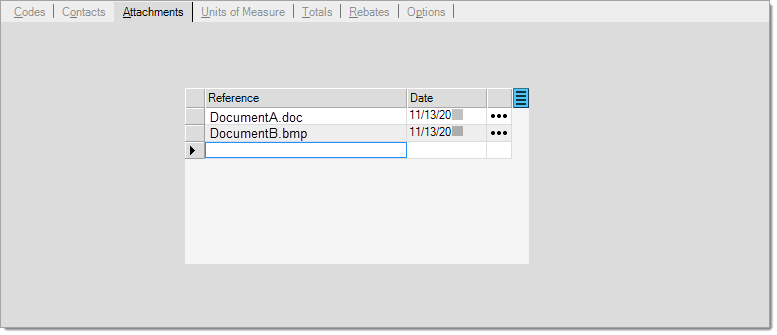Attachments Tab (Vendor Maintenance Form)
The Attachments tab (Alt-A) displays any existing attachments associated with the vendor and you to add or modify attachments associated with the vendor. Adding and modifying attachments cannot be completed when working with vendor data in the Inquiry area. Attachments can be any Microsoft® Windows® type file, map links, web site address (URL), or document ID. Ideas for vendor attachments include trade show documents, driving directions to the nearest warehouse, the vendor's latest sale flyer, copies of manufacturer coupons, product recall notices, return policy statements, or a link to the vendor's web site.
How are Attachments Maintained in the Software?
The attachments you add to accounts and other records are maintained both in the application's SQL database and also in an entirely separate database specifically dedicated to file-based attachment data. Windows File type attachments are not stored locally or saved to disk, but are saved as "image" data in the separate Attachment's SQL database. This separate database is linked with an "attachments" table in the application's database that contains the other information about the attachments (permissions, print settings, type, original path name, etc.). Attachments that are not Windows Files, such as map links and application documents, do not need to be added to the separate database because no external file data is associated with them.
Understanding the Attachment Settings
There are some choices that users can make when adding or modifying attachments. The ability to make changes to attachments may be limited by user security.
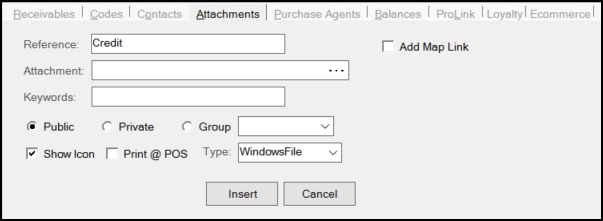
Attachments (Insert)
The Attachments tab displays an Insert button when you are adding a new attachment and Update when you are modifying an existing attachment. For instructions in adding new attachments, please refer to the topic Attachments Step-By-Step. Modifying an existing attachment is relatively easy and the instructions are here.
Reference
Use the Reference field to describe the attachment. References are meant to be unique, so enter information that is specific to the attachment you are adding. When you use the "drag and drop" method to add attachments, the reference defaults to the file name and extension of the file you are adding. If the same Reference name already exists, a message window will ask you whether or not you want to associate the existing attachment with the document instead of creating a new one.
Attachment and Doc # Field
In general, the field below the Reference field is the Attachment field, which lists the current directory path of the attachment or the URL address of the map link or a web site. For file-based attachments, a copy of the file will be stored in a database table that is maintained by the server. Files are not kept individually, they are saved as image data within a SQL table. URL addresses are saved as text. When you choose a Type of Document, the field label updates to Doc #, which is stored in a different area of the application.
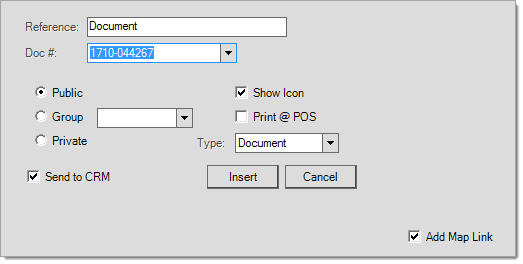
Setting the Attachment Permissions (Public, Group, and Private)
When adding a new attachment, users may choose to make the attachment public, private, or assign it to a user group. Choices affect whether or not the attachment will be visible to a particular user.
•Private attachments are only displayed if the current user is the same user who saved the attachment.
•Group attachments are accessible to just those users who are a member of the assigned (user) group. User Groups are defined from the Messages
•Public attachments are displayed and can be selected and viewed by all users.
The ability to add, modify, and delete attachments may be restricted by general user security as well as by the status of the particular attachment (public, group, or private). Some types of attachments, such as those associated with a record (account, vendor, or item), can only be added, modified, and deleted from a database form (including the Attachment Maintenance form), not from within a transaction. In this case, no browse option is shown and users will be unable to modify path names or save a new attachment. This does not restrict access to view or print record based attachments necessarily; however, that may be limited as well. Contact the system administrator at your company for questions regarding your security permissions.
Choosing the Attachment File Type
Users can choose either windows file, map link, web site address, or document as the file type using the drop down:
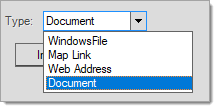
Windows File
"WindowsFile" refers to any Microsoft® Windows®-compatible file type. Usually, these types of files require some other software that may or may not be provided with your Microsoft Windows operating system. These types of attachments are stored in a separate SQL database and table as "image" data, not as individual files in a directory. The same attachment may be used with many different records.
Map Link
"MapLink" refers to a URL (web site address) that initiates a 3rd party mapping service search for a specific address using your default browser. Users may use this site to generate a map to a specific address then click on "link to this page" to create a link address which may then be copied and used as an attachment to a document. Internet access and browser software are required. We are unable to guarantee the accuracy or availability of any 3rd party mapping service. Also, please see the "Add Map Link" section also in this topic.
Web Address
"WebAddress" refers to a normal web site address (URL) which may be either typed in or copied from a web browser's address bar. This option requires Internet access. Web site addresses (URL) must be manually entered or copied into the Attachment text box.
Document
"Document" refers to an application generated document ID. This allows you to enter/select any document ID and save it as an attachment. No data is saved with this attachment, just the document's internal identifier (DocIDInternal) .
Show Icon
The "show icon" check box defaults to yes (checked) and determines whether or not the ![]() (document attachment),
(document attachment), ![]() (customer, job, or vendor attachment), or
(customer, job, or vendor attachment), or ![]() (item attachment) icon is to be shown when this particular attachment is present.
(item attachment) icon is to be shown when this particular attachment is present.
When multiple attachments are present, if any of the attachments are set to "show icon," the icon will display.
Print @ POS
Use this check box to set whether a particular attachment should be made available for printing from the Attachments tab on a transaction's Process (F12) form. It does not cause an attachment to automatically print during processing. In addition, this setting does not prevent a user from opening and subsequently printing any attachments listed on the Info or Entry folders during a Point of Sale transaction. The permissions (public, group, or private) on the attachment are really the only thing that can potentially block access to an attachment.
As stated, even with this setting enabled, printing attachments remains a somewhat manual process. On process forms with an Attachment tab, you can select one or more attachments and then click the Print button. Only those attachments designated as "Print @ POS" are included on the Attachments tab in the Point of Sale Process documents.
Add Map Link
Where provided, the "Add Map Link" check box can automatically create a "Map Link" type attachment that builds the URL request based upon the current account or job address (no automated map link is provided for vendors). Any maps may be optionally displayed in your default browser and require Internet access. The availability and accuracy of any third-party mapping service is not guaranteed.
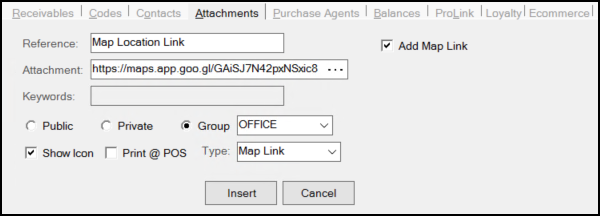
Add Map Link
Modifying Attachments
To modify an attachment:
1. On the Attachments tab, click the Ellipsis  button beside the attachment you want to modify. The attachment details display.
button beside the attachment you want to modify. The attachment details display.
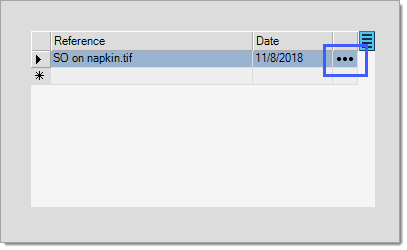
2. Make any changes you need to in the fields provided and click the Update button.
To cancel your changes click Return.
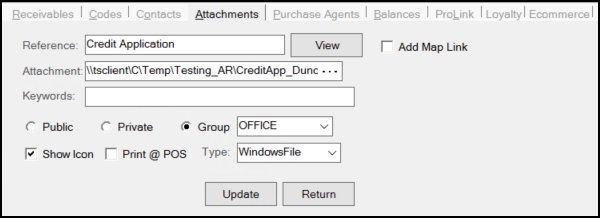
3. Choose Process (F12) to save the changes to the database.
Removing Attachments
To remove an attachment fro the Attachments tab, click the row the attachment is on to highlight it and either click the Delete key or right-click the row and choose Delete from the context menu. Another way to remove record based attachments is to use the Attachment Maintenance utility located under the Maintenance area.
